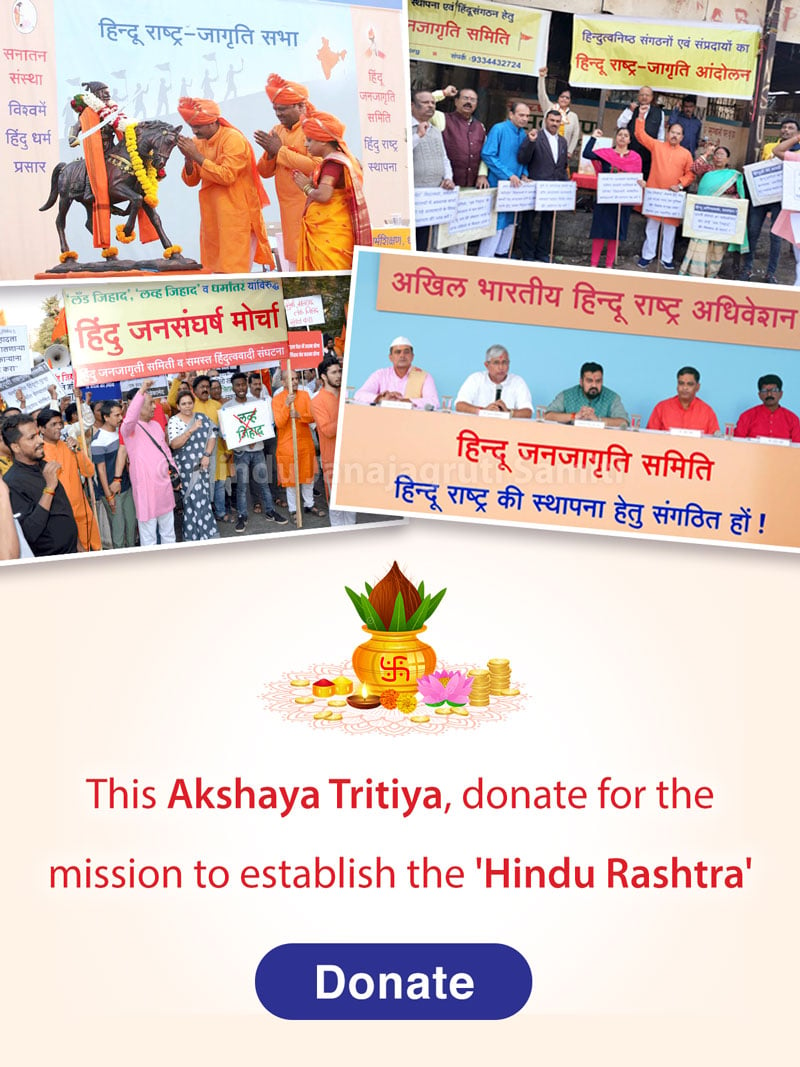Magh Krushna Panchami
- Mulund school to celebrate V-Day as ‘Matru-Pitru Din’ (14 Feb 09)
- Valentine’s Day and Vulgarisation of modern life (13 Feb 09)
Mumbai: Students of Laxmibai English Medium school will wash their parents’ feet and perform aarti, then seek their blessings in their own unique version of Valentine’s Day.
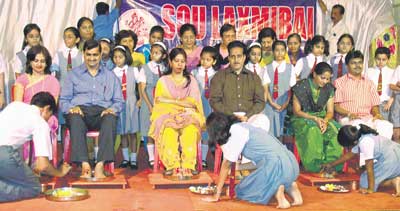 Students rehearse for the Valentine’s Day celebrations on Friday |
This will probably be one of the few Valentine’s Day celebrations that neither the Shiv Sena, Sri Ram Sene or any right wing political party will oppose.
The Laxmibai English Medium school in Mulund has decided to celebrate the day as ‘Matru-Pitru Din’ – parents’ day. Parents have hailed this concept.
"Youngsters usually think of celebrating Valentine’s day with their friends. It feels nice when you become the Valentine of your children. We are really pleased with the idea," said Ashwini Dadpe, mother of Rutuja, a class VIII student of the school.
Dinesh Faria, father of Niti who studies in class II said, "Instead of banning the day because of the way it is perceived now, the school has shown the right way to celebrate it and we are very happy."
In the celebrations that will start at 8.30 am, the students will wash their parents’ feet with water and perform their ‘aarti.’ The parents will then bless their children.
"Earlier, this is how children would seek the blessings of their parents. As times have changed, the practices too have changed. Today, the tradition of seeking the blessings of your parents by bowing before them is fast disappearing. We feel that conducting a ‘puja’ this way will revive that concept among our children and strengthen their bond with their parents," said Prasad Kulkarni, the president of the school.
The students too are enthusiastic about the idea. Says Rutuja, "Whenever there are such days, we tend to celebrate them with our friends.But when the announcement regarding this day was made, everyone in my class really felt pleased. Instead of just trying to ban Valentine’s Day, the school decided to celebrate it in the right way."
Gaurav Borse, a student of class VIII said, "We usually celebrate Valentine’s Day with gifts of soft toys, roses etc for friends. I have never sought my parents’ blessings this way, so I am very happy I got the chance to do so."
Source: mumbaimirror.com
Valentine’s Day and Vulgarisation of modern life
February 13, 2009
By Sunanda K Datta-Ray
Despite the Sri Ram Sena’s ‘tie-or-die’ threat, Valentine’s Day is likely to pass off without much disruption. This is partly because of the combative public response to the Mangalore hooliganism and partly because of the Karnataka Chief Minister’s belated acknowledgment of his duty to maintain law and order. But neither matters much in the larger context of the vulgarisation of life. Westernisation, which has become synonymous with modernisation, means shopping malls and fast food joints instead of the libraries and reform movements of the 19th century.
Valentine’s Day itself is a recent services industry conspiracy to persuade gullible semi-literate folk that they are ‘with it’ if they squander money on gifts, cards and parties on an occasion that holds no meaning in their lives. Sadly, commercial radio channels pander to social ambition with a false picture of the good life and by constantly urging listeners to ‘celebrate’ Valentine’s Day in cheap imitative fashion. If ever there was a case for censorship, it is here even if radio’s tasteless propaganda is popular because norms are set by society’s lowest common denominator.
This triumph of democracy highlights what Asok Mitra, the scholarly civil servant, called the Plebeian Revolution in a perceptive essay nearly 50 years ago. It is the inevitable outcome of the combination of majority rule, relaxed governance, higher disposable incomes and greater exposure to global trends combined with woefully insufficient education. Many responsible Indians — not just cranks, bigots and goondas — find the changes disturbing if not objectionable.
This is not the first time diehards have objected to what they see as contaminating foreign influence. Resistance was no less vehement in the 19th and early-20th centuries when the Bengal Renaissance gave birth to social reform movements supporting monotheistic worship, widow remarriage, female education and abolition of sati and the caste system. Brahminical orthodoxy viewed these innovations with as much horror as Rajasthan’s Chief Minister, Mr Ashok Gehlot, apparently regards “the culture of boys and girls going hand-in-hand to pubs and malls for drinking”. Opposition forced the Brahmo Samaj to camouflage its meeting places in many mofussil towns as non-denominational prayer halls. Several of my ancestors were asked (but refused) to perform the prayaschitta — penance — ceremony after returning from their studies in England.
The nature of protest has kept pace with modern times and Sena activists are also a feature of the emerging India. Earlier critics of Western ideas and practices thundered at public meetings, issued stormy manifestos and ensured that offenders were denied the services of dhobis and barbers. Thanks to them, boycotts thrived in Bengal before Captain Boycott, an English landowner’s agent in Ireland, was a victim of the strategy that commemorates his name.
Today’s objectors indulge in abuse and beatings. It would be profanity to equate the Bengal Renaissance with what Mr BS Yeddyurappa calls ‘pub culture’. But just as Heaven and Hell are both states after death, these two also have something in common: Both reflect Indian absorption of Western trends. The qualitative difference between earlier change and the Westernisation that is now sweeping the young is a reminder that an open window lets in the fresh air but also brings flies and other pests.
The Bengal Renaissance’s social and cultural effects were confined to the elite whereas the impact now is on a broad mass of people whose adoption of alien lifestyles is not leavened by the enlightenment that comes of learning. The recipient’s own status and culture determine the level of his access to foreign lifestyles. India’s elite was shaped in a privileged Western crucible and absorbed the highest forms of Western thought. Hoi-polloi soaks up the mass entertainment offered by Western television and its Indian imitations. No fare satisfies the multitude if it does not have a vulgar dimension. Vulgarity is universal like the cell phone, that contemporary symbol of modernisation, flaunted by both toddy-tappers and rickshaw-pullers. Delhi’s Tamarind Court, scene of a famous murder, and Mangalore’s Amnesia bar are fruits of the same mix.
This wider spread of Western influence reflects the transfer of the decisive role from the few to the many that is dramatically evident in political life. Barristers and zamindars have given way to operators with more than a sprinkling of criminals. Interests take precedence over causes. Caste matters more than class. Means are sacrificed to ends. There can be no harmonious cultural synthesis when profit-driven commerce spurs instant change. Ever alert for sensation, television publicises and perpetuates incongruous combinations of East and West.
As for the spurious claim by Mr Pramod Muthalik, the Sri Ram Sena founder, a former Bajrang Dal luminary and president of the Rashtriya Hindu Sena, to protect ‘Indian culture’, even someone more discerning would find it impossible to draw a line and say this is alien or this is not indigenous. Taking four names at random, Yuki Bhambri and Ishant Sharma began celebrating victory by clenching their fists and letting out bloodcurdling yells after David Beckham and Roger Federer did so. JBS Haldane, the eminent scientist, reminded us that the officially favoured sherwani was as foreign as the lounge suit, being adopted from another conqueror. A widely published picture from Mangalore shows not a saffron-draped greybeard with matted locks but a modishly long-haired youth in bush shirt and flares. His lips are pressed menacingly as his left hand grips another man’s shirt while the right is poised to strike. It could depict any brawl outside a saloon in a Wild West film.
Western cinema (direct or via Bollywood) influences posture, mannerism and diction in the unlikeliest circles. All people mean when they insist that something is not Indian is that they have not come across it in India’s diversity. It’s the hallmark of small-town thinking to regard one’s own milieu as the norm and every deviation from it as foreign or unnatural.
The nub of the matter is that Westernisation now affects the dress, speech, behaviour and responses of a much wider spectrum of Indian society than before. If the multitude is going to adopt something, it can only be at the level that is meaningful to the multitude. The refinement of an Oxford Senior Common Room cannot be expected at a mass level. It has to be the raucous boisterousness of a music hall or pub. It’s the price of exalting political emancipation above social enlightenment.
Source: dailypioneer.com

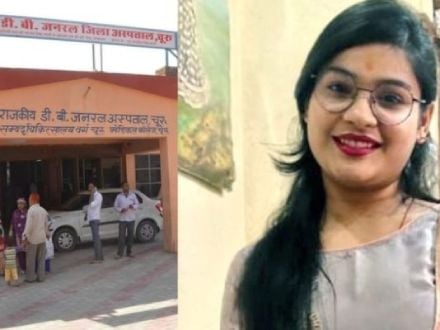 Rajasthan: Woman found hanging at a beauty parlour, Arshad, 3 others booked
Rajasthan: Woman found hanging at a beauty parlour, Arshad, 3 others booked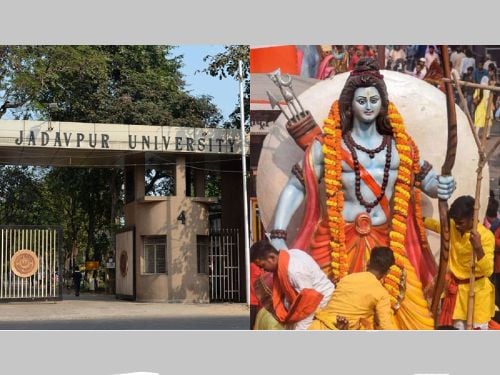 Jadavpur Univ revokes permission to celebrate Ram Navami on campus after granting it
Jadavpur Univ revokes permission to celebrate Ram Navami on campus after granting it Andhra Pradesh: Farooq kills mentally challenged Hindu man for insurance money
Andhra Pradesh: Farooq kills mentally challenged Hindu man for insurance money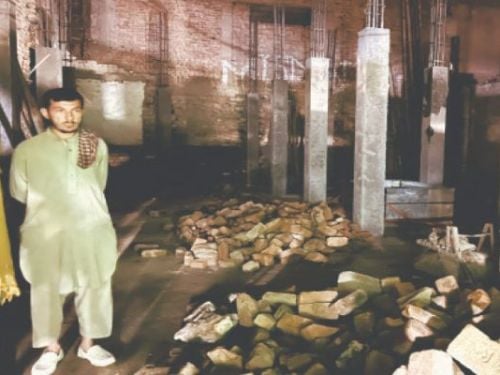 Pakistan: Ancient Hindu temple in Khyber Pakhtunkhwa demolished for commercial complex
Pakistan: Ancient Hindu temple in Khyber Pakhtunkhwa demolished for commercial complex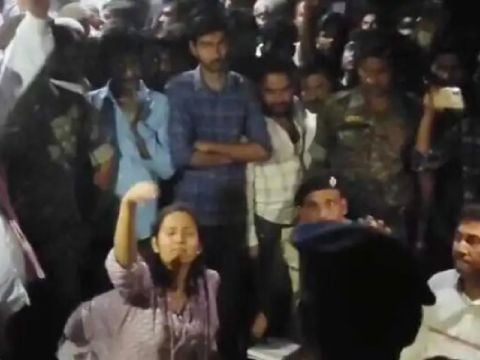 Bihar: Goddess Bhagavati Temple in Araria vandalised and deities damaged
Bihar: Goddess Bhagavati Temple in Araria vandalised and deities damaged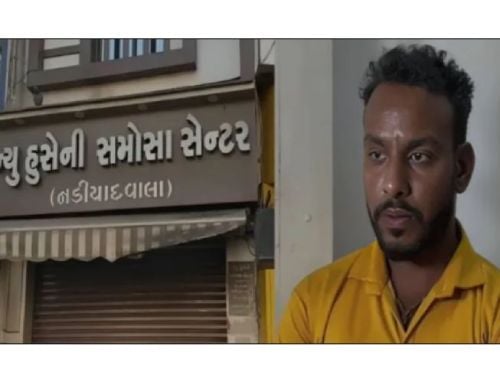 Vadodara: Beef supplier Imran Qureshi arrested in beef-stuffed samosa case
Vadodara: Beef supplier Imran Qureshi arrested in beef-stuffed samosa case